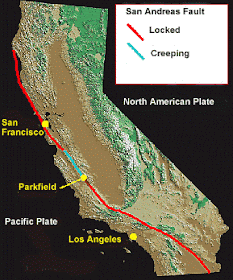San Andreas Fault
 |
| San Andreas fault aerial view |
San Andreas fault is a continental transform fault extended over an area approximately 810 miles through California state. It is a right lateral strike slip fault with plate boundary with Pacific plate and North American plate. The fault has three segments where each segment has different characteristics and can originate a different degree of earthquake risk. The most significant being the southern part because it passes through 35 miles of Los Angeles. The name San Andreas is from the San Andreas lake which is a small body of water that was formed in a valley between the two plates. Transform fault is the sliding boundary between two plates. In San Andreas fault there are much of the fractures and faults associated with it which marks the zone where these two plates meet. San Andreas fault is about 28 years old when these plates first interacted. These plates are slowly moving along each other.
 |
| San Andreas fault map showing locked and creeping zones |
The two plates are siding with each other at the rate of a couple inches through the year. This rate of movement is spectacular and can develop significant amount of strain with the boundary of the two plates. As shown in the photograph, there are areas which are marked red that is locked down and no movement is along them nowadays and the blue shows the moving area of the fault. As the locked up places does feel the stress but due to stuck plates, no movement is being caused in these areas. But this will never be the same but instead when stress is greater then it can accommodate, one day it will show abrupt movement as was in 1906 earthquake when sudden movement was approximately 21 feet on the areas which were locked. Lets have a look back at the earthquakes generated by the San Andreas fault preserved in the history.
Earthquakes from the San Andreas fault
The first recorded earthquake from the San Andreas fault is in 1769 then was in December 8. 1812 killing forty persons. Later in January. 1857 which was severe shock then is in October, 1868 killing thirty persons. Then is in March 1872, killed 27 people and on April 19, 1892 Vacaville was damaged. On Christmas day in 1899 six person died because of earthquake from San Andreas. Then the giant earthquake of April 18, 1906 which killed 700 people including total damage of $500 million. Damage of $1 million was done by June 22, 1915 earthquake $200,000 in April 1918. Other are in June 1925 with damage of $8 million, November, 1927 earthquake, March 1933, May 1940 and July 1952. All earthquakes were severe some more and some less damage causing.
Latest study of the San Andreas fault
Of the hundreds of seismogenic (earthquake causing) geologic faultsin California, UCERF (Uniform California Earthquake Rupture Forecast) classifies only six faults as Type A sources, meaning there is sufficient information to both estimate and model the probability of a Magnitude (M) 6.7 or greater earthquake within 30 years. These six faults are the: (1) San Andreas (split into northern and southern sections, (2) San Jacinto, (3) Elsinore, (4) Garlock, (5) Calaveras, and (6) Hayward-Rodgers Creek. Faults which are known to be slipping (and therefore seismogenic) but lack sufficient information to fully model how close they might be to rupture are classified as Type B. About twenty of these faults are estimated to have a 5% or greater chance of an M ≥ 6.7 earthquake within 30 years. An additional six areas where strain is accumulating but where knowledge is insufficient to apportion slip onto specific faults are classified as Type C sources.There is additional chance of earthquakes on faults that were not modeled, and of lesser earthquakes. Northern California has an estimated 12% chance over the same 30 years of an M ≥ 8 mega thrust earthquake on the Cascadia subduction zone. UCERF has also prepared "participation probability maps" of the chance that any area will experience an earthquake above a certain magnitude from any source in the next 30 years.